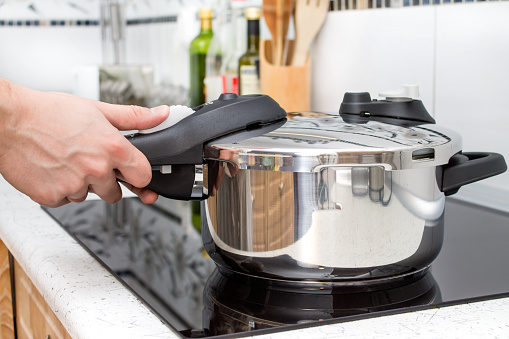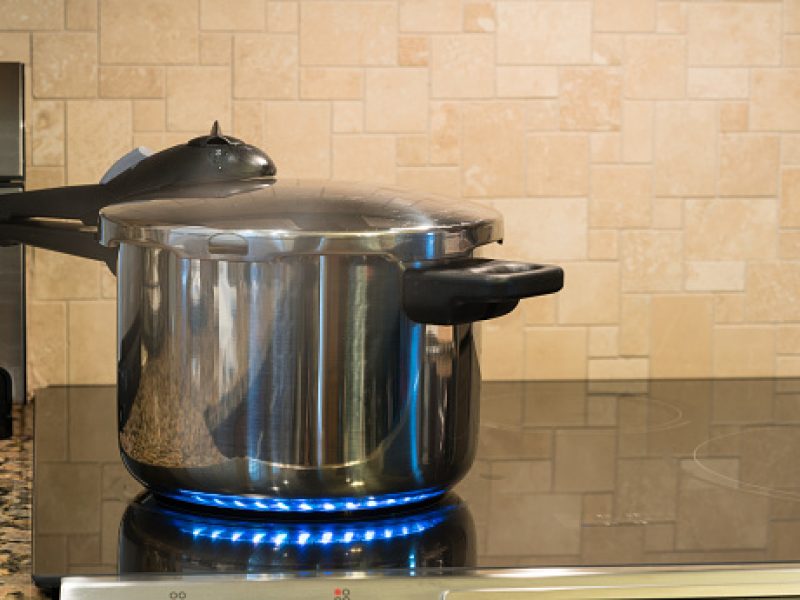Pressure Cooker Guide

Pressure Cooker Guide
Here at Curry Fayre, our goal is to help people understand all the different types of Indian cooking utensils needed to make delicious curries. Most of these utensils are authentic cooking equipment from India, yet there are some things we can use that are a little closer to home.
One popular device for cooking Indian food that you have probably heard of is the pressure cooker. This device is common in kitchens around the world, being incredibly versatile to the point where you can make all kinds of cuisine without much effort.
If you want to take your homemade curries to a whole new level, then you seriously want to consider buying a great pressure cooker! These devices are perfect for not just curries, but also many other types of dishes, from other Indian fare to all your favourite homemade recipes.
Below is an extensive guide covering all the useful information you need to know to find the best pressure cooker for Indian food!
What is a Pressure Cooker?
A pressure cooker uses high pressure steam to cook food, usually in a much quicker time compared to other cooking methods.
A traditional pressure cooker consists of a large pot with a sealed lid that is placed on a stove top. Modern pressure cookers are electric, working as a self-contained cooking device, similar to a slow cooker or rice cooker.
An electric pressure cooker comes with various automatic inputs and settings, allowing you to cook all kinds of recipes with the press of a few buttons, including Indian foods like curry and dal. They are usually temperature controlled, with the lid automatically sealing to maintain the required cooking temperature.


Reasons to Buy a Pressure Cooker for Indian Food
With the best pressure cooker, you can expect to make incredible homemade curry without much effort. Most of these devices are incredibly straight-forward to use – simply add the ingredients, push the required setting, and leave the pressure cooker to do the rest.
An Indian curry uses a wide selection of ingredients, which is why they taste so good, yet this process means waiting a while for all the ingredients to blend. If you have made a curry from scratch at home, you probably know how long some recipes take to complete!
With a pressure cooker, Indian foods like curries are made in a fraction of the time they take on a stove top. This means enjoying your favourite curry or dal in as little as half an hour – great for those hectic weekdays where you want to make a quick but delicious dinner.
Moreover, the ingredients commonly used in Indian meals taste amazing when pressure cooked. For instance, beans and lentils are widespread in many Indian recipes, and a pressure cooker will have these ready quickly and cooked to perfection.
Because a pressure cooker uses a sealed lid to maintain the required pressure for cooking, the device retains an incredible amount of flavour.
Similarly, tougher cuts of meat used in a curry often require long cooking times. With a pressure cooker, the meats in your curry are cooked to perfection, becoming soft and succulent without taking too long to be ready.
Simply put, your curries will taste out of this world.
Furthermore, the best pressure cookers are not just suitable for Indian food! This is a versatile cooking utensil that has countless uses in the kitchen, allowing to quickly cook various types of cuisine without much effort.
How to Find the Best Pressure Cooker for Indian Food?
With so many good pressure cookers on the market, finding the best one for making Indian food is not always easy. Here are some things to consider when you are buying a pressure cooker:
Stovetop or Electric
A stovetop pressure cooker is basically a large pot with a sealed lid, which helps to maintain the temperature needed to produce steam for cooking. While cheaper than an electric pressure cooker, a stovetop device does lack the various cooking options and settings, so consider how easily you want to cook these meals.
Electric pressure cookers are often included in multi-cooking devices that combine serval devices in one, such as a pressure cooker, slow cooker, and rice cooker. These are more versatile but will cost a lot more than a standard electric pressure cooker.
For most beginners making curries and other Indian fare, we recommend an electric pressure cooker. They are simple to use, will quickly cook curries, and can be used for all kinds of other recipes.
Plus, once you get more familiar with making curries, you can tinker with the settings to further improve your recipes!
Material
Stainless steel is the best material for a pressure cooker, electric or stovetop, being durable and great at retaining heat, which is important for maintaining the pressure. Aluminium is another material used, although it is lighter so less durable, with steel your best option.
Safety
Always check the locking mechanism on a pressure cooker. You want a robust lock that keeps the lid in place, ensuring there is no risk of steam escaping and injuring you. Again, an electric pressure cooker is best for this, as they come with various safety features including auto-shut off and pressure release.
Features
Consider what features you want included with a pressure cooker. A stovetop cooker will have one basic cooking method, while electric pressure cookers come with various pre-set controls and settings for cooking.
For example, the best electric pressure cookers come with both high pressure and low pressure cooking. Lower pressure is good for gentler ingredients, while high pressure is perfect for common ingredients in curries like meats, beans, and legumes.
Size
Consider what portion sizes you make on an average day, using this to help choose a suitable sized pressure cooker. For example, if you are only making meals for one or two people, you can get a compact pressure cooker that will save space.
Conversely, those making food for several people will likely require a larger capacity pressure cooker. Most come with a good size container for cooking – just make sure it is enough for your needs!